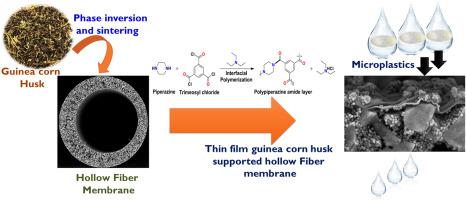Journal of Hazardous Materials ( IF 12.2 ) Pub Date : 2021-09-20 , DOI: 10.1016/j.jhazmat.2021.127298 Lukka Thuyavan Yogarathinam 1 , Jamilu Usman 2 , Mohd Hafiz Dzarfan Othman 1 , Ahmad Fauzi Ismail 1 , Pei Sean Goh 1 , Arthanareeswaran Gangasalam 3 , Mohd Ridhwan Adam 1

|
In this study, an economic silica based ceramic hollow fiber (HF) microporous membrane was fabricated from guinea cornhusk ash (GCHA). A silica interlayer was coated to form a defect free silica membrane which serves as a support for the formation of thin film composite (TFC) ceramic hollow fiber (HF) membrane for the removal of microplastics (MPs) from aqueous solutions. Polyacrylonitrile (PAN), polyvinyl-chloride (PVC), polyvinylpyrrolidone (PVP) and polymethyl methacrylate (PMMA) are the selected MPs The effects of amine monomer concentration (0.5 wt% and 1 wt%) on the formation of poly (piperazine-amide) layer via interfacial polymerization over the GCHA ceramic support were also investigated. The morphology analysis of TFC GCHA HF membranes revealed the formation of a poly (piperazine-amide) layer with narrow pore arrangement. The pore size of TFC GCHA membrane declined with the formation of poly (piperazine-amide) layer, as evidenced from porosimetry analysis. The increase of amine concentration reduced the porosity and water flux of TFC GCHA HF membranes. During MPs filtration, 1 wt% (piperazine) based TFC GCHA membrane showed a lower transmission percentage of PVP (2.7%) and other suspended MPs also displayed lower transmission. The impact of humic acid and sodium alginate on MPs filtration and seawater pretreatment were also analyzed.
中文翻译:

从几内亚玉米壳灰中提取的低成本二氧化硅基陶瓷负载薄膜复合中空纤维膜用于有效去除水溶液中的微塑料
在这项研究中,一种经济的二氧化硅基陶瓷中空纤维 (HF) 微孔膜由几内亚玉米壳灰 (GCHA) 制成。涂覆二氧化硅中间层以形成无缺陷的二氧化硅膜,该膜可作为薄膜复合材料 (TFC) 陶瓷中空纤维 (HF) 膜的支撑,用于从水溶液中去除微塑料 (MP)。聚丙烯腈 (PAN)、聚氯乙烯 (PVC)、聚乙烯吡咯烷酮 (PVP) 和聚甲基丙烯酸甲酯 (PMMA) 是选定的 MPs 胺单体浓度(0.5 wt% 和 1 wt%)对聚(哌嗪-酰胺)形成的影响) 层通过 GCHA 陶瓷载体上的界面聚合进行了研究。TFC GCHA HF 膜的形态分析表明形成了具有窄孔排列的聚(哌嗪-酰胺)层。TFC GCHA 膜的孔径随着聚(哌嗪-酰胺)层的形成而下降,这从孔隙率分析可以看出。胺浓度的增加降低了 TFC GCHA HF 膜的孔隙率和水通量。在 MPs 过滤过程中,基于 1 wt%(哌嗪)的 TFC GCHA 膜显示出较低的 PVP 透过率(2.7%),而其他悬浮 MPs 也显示出较低的透过率。还分析了腐植酸和海藻酸钠对 MPs 过滤和海水预处理的影响。7%)和其他被停职的议员也表现出较低的传输率。还分析了腐植酸和海藻酸钠对 MPs 过滤和海水预处理的影响。7%)和其他被停职的议员也表现出较低的传输率。还分析了腐植酸和海藻酸钠对 MPs 过滤和海水预处理的影响。











































 京公网安备 11010802027423号
京公网安备 11010802027423号